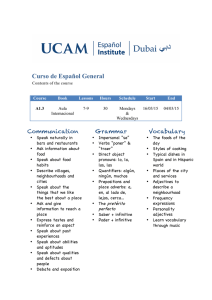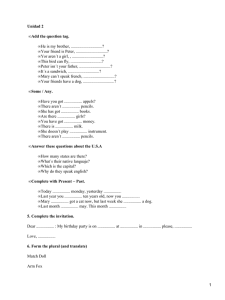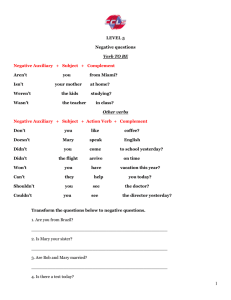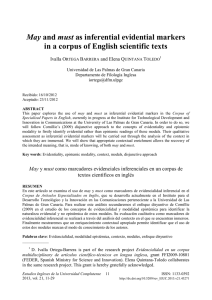Some Epistemic Indefinites* Luis Alonso
Anuncio
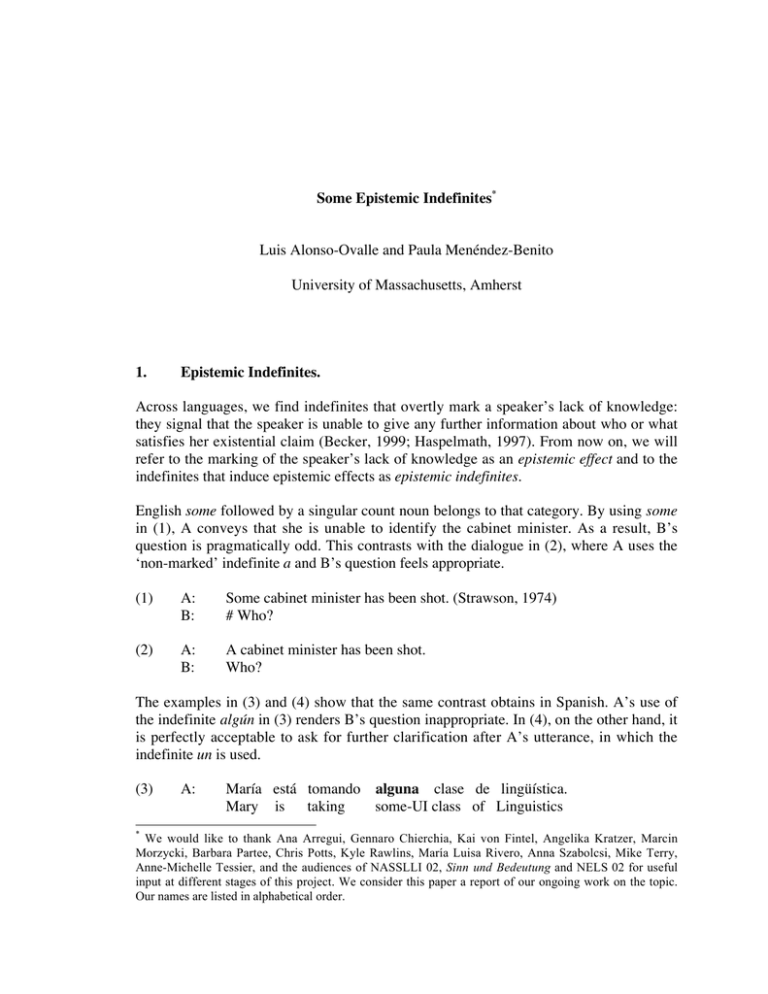
Some Epistemic Indefinites*
Luis Alonso-Ovalle and Paula Menéndez-Benito
University of Massachusetts, Amherst
1.
Epistemic Indefinites.
Across languages, we find indefinites that overtly mark a speaker’s lack of knowledge:
they signal that the speaker is unable to give any further information about who or what
satisfies her existential claim (Becker, 1999; Haspelmath, 1997). From now on, we will
refer to the marking of the speaker’s lack of knowledge as an epistemic effect and to the
indefinites that induce epistemic effects as epistemic indefinites.
English some followed by a singular count noun belongs to that category. By using some
in (1), A conveys that she is unable to identify the cabinet minister. As a result, B’s
question is pragmatically odd. This contrasts with the dialogue in (2), where A uses the
‘non-marked’ indefinite a and B’s question feels appropriate.
(1)
A:
B:
Some cabinet minister has been shot. (Strawson, 1974)
# Who?
(2)
A:
B:
A cabinet minister has been shot.
Who?
The examples in (3) and (4) show that the same contrast obtains in Spanish. A’s use of
the indefinite algún in (3) renders B’s question inappropriate. In (4), on the other hand, it
is perfectly acceptable to ask for further clarification after A’s utterance, in which the
indefinite un is used.
(3)
*
A:
María está tomando alguna clase de lingüística.
Mary is taking
some-UI class of Linguistics
We would like to thank Ana Arregui, Gennaro Chierchia, Kai von Fintel, Angelika Kratzer, Marcin
Morzycki, Barbara Partee, Chris Potts, Kyle Rawlins, María Luisa Rivero, Anna Szabolcsi, Mike Terry,
Anne-Michelle Tessier, and the audiences of NASSLLI 02, Sinn und Bedeutung and NELS 02 for useful
input at different stages of this project. We consider this paper a report of our ongoing work on the topic.
Our names are listed in alphabetical order.
(4)
B:
#¿Cuál?
Which one?
A:
María está tomando una clase de lingüística.
Mary is taking some class of Linguistics
¿Cuál?
Which one?
B:
Judging from these data, one could imagine that epistemic indefinites are uniformly
characterized by the same epistemic effects. However, despite their superficial similarity,
the epistemic effect of some and that of algún differ: while both (5) and (6) indicate that
the speaker is unable to provide the identity of the man that Mary is dating, they are not
appropriate in the same scenarios. By uttering (5) the speaker signals that, as far as she
knows, María might be dating any of the men in the Linguistics Department (we will dub
the type of epistemic effect that algún induces a free choice epistemic effect). In contrast,
a speaker can utter (6) even when she knows that there are some men in the Linguistics
department that Mary cannot possibly be dating.
(5)
María está saliendo con algún
chico del departamento de lingüística.
Mary is going out with some-UI guy of the department of Linguistics
(6)
Mary is dating some guy from the Linguistics Department.
In this paper we will show that the epistemic effect of algún can be derived in the same
way Kratzer and Shimoyama (2002) derive the interaction of German irgendein with
modals. Crucially, we will assume that algún widens its domain and that assertions are
implicitly modalized. Although we will not give a complete account of the epistemic
effect of some, we would like to suggest that in order to do so it would be necessary to
pay attention to the different ways we can have discriminating knowledge about
individuals (even though some expresses ignorance, it can be used when making a claim
about an individual with which the speaker has direct perceptual acquaintance.)
2.
The Free Choice Epistemic Effect of Algún.
In order to see what we mean by free-choice epistemic effect, it may be useful to take a
look at the following two scenarios:
Scenario 1
There are five male linguists in the department: John, Bill, Charles, Richard and Mike. I
have heard, from a trustworthy source, that María is dating one of them. But that is all I
know; I have no idea which of them she is dating.
My epistemic alternatives in Scenario 1 are depicted in Figure 1:
Fig. 1: My relevant epistemic alternatives in Scenario 1.
Mary is dating John
Mary is dating Charles
Mary is dating Bill
Mary is dating Richard
Mary is dating Mike
Scenario 2
There are five male linguists in the department: John, Bill, Charles, Richard and Mike. I
have heard, from a trustworthy source, that María is dating a linguist in the department. I
know she is not dating Mike, I know she is not dating Richard, and I know she is not
dating Charles. So, according to what I know, María can be dating John or she can be
dating Bill.
My epistemic alternatives in Scenario 2 look as in Figure 2:
Fig. 2: My relevant epistemic alternatives in Scenario 2.
Mary is dating John
Mary is dating Bill
The sentence in (5) (repeated below as (7)) can felicitously describe Scenario 1, but not
Scenario 2.
(7)
María está saliendo con algún
chico del departamento de lingüística.
Mary is going out with some-UI guy of the department of Linguistics
By using algún the speaker signals that, as far as she knows, the linguist that María is
dating might be any of the five men in the domain. In other words, for each x in the
domain, there has to be an epistemic alternative w such that the proposition that Mary is
dating x is true in w. This is the free-choice epistemic effect.1
As for some, speakers vary. Some of our consultants consider (8) below to be good in
both scenarios.
(8)
1
Mary is dating some linguist in the department.
One can read Lenz’s (1944) grammar as hinting at this kind of effect.
Other speakers find (8) inadequate, probably because the scenarios make very plausible
that the speaker is familiar with the linguists in question. This points to a further
difference between some and algún, which we hope to be able to discuss in future work.2
So far, we have shown that algún exhibits a free-choice epistemic effect. The examples in
the next section show that the epistemic effect of some is not a free-choice one: some can
be used in scenarios where the indefinite is understood to concern a particular individual.
3.
The Non-Free Choice Epistemic Effect of Some.
Some can have a referential use. Consider, for instance, the following scenario:
Scenario 3.
L and P are talking in the lounge of the Math department, on one of those long, boring,
predictable winter evenings when everybody is doing what they are supposed to. Neither
L nor P knows anybody there. All of a sudden, a burst of Brazilian music starts to play in
an office. Believe it or not, there is a guy dancing lambada on his desk. Unbeknownst to
L and P, the guy is Rino Cusper, the famous statistician.
In that scenario, P can utter (9) felicitously.
(9)
Look! Some professor is dancing lambada on his table.
On the other hand, the Spanish sentence in (10) is bad in the scenario above.
(10)
#¡Mira! algún
profesor está bailando la lambada encima de la mesa.
Look! some-UI professor is dancing lambada on
the table
Algún is incompatible with scenario 3 because it is not the case that, as far as P knows,
any professor in the relevant domain could be the one dancing lambada. P is actually
seeing the professor in front of her. It is true that she can’t name him —she can’t say that
Rino Cusper is dancing lambada. (That is exactly what she is signaling by using some in
(9)). What she does know, however, is that that guy over there is dancing lambada: Were
2
Judgments improve in the following scenario, where the speaker is not likely to be acquainted in any way
with the individuals in the relevant domain.
Yesterday,!I clearly saw a!guy with a long beard trying to get into my car. The police have identified
five men as suspects and asked me to identify them. I could look at them all through a one-way glass.
Three of them, (suspects a, b, and!c) didn't have beards and I am pretty sure none of them was the man I
saw at the parking lot.! But I was startled: the remaining two (suspects d and e) wore long beards.! I am
pretty sure that either d or e tried to get into my car.
While most of the speakers we consulted found (i) appropriate in that scenario, there were a couple of
exceptions. Barbara Partee (p.c.) suggests that some may not like to select from such a small closed set.
(i)
Some man in that room tried to get into my car.
she presented with all the professors in the Math department and asked who the one
dancing lambada was, she would be able to pick Rino Cusper among them. Hence, the
use of algún, which requires that all members in the domain are possible options, would
be inappropriate.
Now consider a slight modification in the scenario:
Scenario 3 Modified.
Strange things happen! L and P are outside the office where a faculty meeting is being
held. Suddenly, they hear lambada music coming out of the office and sounds that
unequivocally indicate that a person is dancing to the music.
Now P can utter the sentence in (10) quite appropriately. As far as she knows, any
professor (in that room) could be the one dancing lambada.
The epistemic effect induced by some is not a free-choice one. The some-sentence in (9)
can be used to describe Scenario 3 in which it is not true that as far as the speaker knows,
any professor might be dancing lambada.
4.
How to Derive the Epistemic Effect of Algún: Kratzer and Shimoyama (2002)
Kratzer and Shimoyama derive the behavior of the German indefinite irgendein in
interaction with modals from the assumption that irgendein imposes domain widening.
They suggest in passing that their analysis should carry over to the epistemic uses of
irgendein. In this section, we will go through their proposal and show how it accounts for
the epistemic effect induced by algún.
4.1
Indefinites in Kratzer and Shimoyama’s System.
Kratzer and Shimoyama propose that indefinite DPs denote the set of contextually
relevant individuals that satisfy the extension of the NP. Thus, the denotation of a girl
will be the set of girls in a contextually given domain.
(11)
a.
b.
Let D be a variable ranging over sets of individuals,
[[aD girl]]w,g = {x: x is a girl in w & x is in g(D)}
Illustration: Let g(D) = {x: I had dinner with x last night} = {Leonor
Waitling, Michelle Pfeiffer, Cary Grant},
[[aD girl]]w,g = {Leonor Waitling, Michelle Pfeiffer}
In Kratzer and Shimoyama’s Hamblin semantics, we get a set of propositional
alternatives by combining indefinites with predicates. Indefinites denote sets of
individuals. Predicates denote functions from individuals to propositions.3 Indefinites
combine with predicates by pointwise functional application, as illustrated below:
3
In Kratzer and Shimoyama’s system, denotations are uniformly sets. The denotation of a predicate is not a
function from individuals to propositions, but rather a singleton containing it. The denotation of a sentence
(12) a.
b.
A girlD came to the party
Let g(D) = {Leonor Waitling, Michelle Pfeiffer}
[[came to the party]]w,g ([[aD girl]]w,g ) =
lxlw’. x came to the party in w’ ({Leonor Waitling, Michelle Pfeiffer} ) =
lw’. Leonor Waitling came to the party in w’,
lw’. Michelle Pfeiffer came to the party in w’
Kratzer and Shimoyama let modals operate on sets of propositions4. A sentence
containing a necessity modal is true if and only if for each accessible world w, there is at
least one proposition in the set the modal operates over that is true in w.
As an illustration, consider what happens if we embed the sentence in (12a) under Mary
knows, as in (13). Let us assume that know is an epistemic necessity modal. The modal
takes a set containing two propositions: the proposition that Leonor came to the party and
the proposition that Michelle came to the party. The sentence in (13) will be true iff for
every epistemic alternative of Mary w, Leonor came to the party in w or Michelle came
to the party in w (or both Leonor and Michelle came to the party in w.)
(13)
Mary knows that a girlD came to the party.
4.2
Kratzer and Shimoyama’s Analysis of Irgendein.
According to Kratzer and Shimoyama, irgendein induces domain widening. The
semantics of irgendein looks as in (14), following Chierchia (2001): Irgendein Mann
denotes the set of all men in the world of evaluation.
(14)
[[irgendeinD Mann]]w,g ={x:$g’ [x is a man & x Œ g’(D)]} = {x: x is a man in w}
Each time we combine a domain widening element like irgendein with a predicate, we
get a maximal set of alternatives:
(15)
Mary knows that irgendeinD girl came to the party.
[[Mary knows]]w,g
lw’. Leonor Waitling came to the party in w’,
lw’. Michelle Pfeiffer came to the party in w’,
lw’. Ariadna Gil came to the party in w’,
lw’. Sandy came to the party in w’,
… for all the girls in w.
The semantics of the modal tells us that the sentence in (15) is true iff for every epistemic
alternative of Mary w, at least one of the girls in the domain came to the party in w.
is not a proposition, but a singleton containing a proposition. For the sake of simplicity, we will ignore this
point here.
4
Aloni (2002) makes the same move.
According to this, (15) can be true in scenarios where there are girls that do not constitute
an epistemic possibility for Mary. The sentence in (15) would be true, for instance, in a
situation in which Mary knows that Sandy came to the party (represented in (16a)) or in a
situation in which, as far as Mary knows, either Sandy or Leonor might have come to the
party (represented in (16b)).
(16)
a.
w1 Sandy came to the party b.
w2 Sandy came to the party
w3 Sandy came to the party
w4 Sandy came to the party
w1 Sandy came to the party
w2 Leonor came to the party
w3 Sandy came to the party
w4 Leonor came to the party
As it turns out, the sentence in (15) cannot appropriately describe the scenarios in (16). In
order for it to be felicitous, each of the propositions in the set operated over by the modal
has to be true in at least one of Mary’s epistemic alternatives. Kratzer and Shimoyama
dub this effect the ‘distribution requirement’ and propose that it comes about as an
inference drawn by the hearer on the basis of the domain widening induced by irgendein.
Building on Kadmon and Landman (1993), Kratzer and Shimoyama assume that domain
widening must serve a purpose. In the case of ‘pure’ existentials like irgendein, domain
widening may be due to two reasons: avoiding a false claim and avoiding false
exhaustivity inferences.
To see what exhaustivity inferences are, consider the following dialogue:
(17)
A:
B:
Which tube stations are one stop from Oxford Circus?
Piccadilly Circus, Bond Street, Tottenham Court Road, Green Park,
Warren Street, Regent’s Park are each one stop from Oxford Circus
(Zimmerman, 2000).
A will normally take B’s response to be exhaustive. That is, A will draw the
(exhaustivity) inference5 that the only underground stations that are one stop from Oxford
Circus are the ones mentioned in B’s answer (Groenendijk and Stokhof, 1984).
Let us go back to example (15). For the sake of illustration, let us assume that there are
only two girls in our world: Renée and Sandy. If these are all the girls in the world, then
the set the modal operates on contains just two propositions, as shown below.
(18)
[[Mary knows]]w,g
lw’. Renée came to the party in w’,
lw’. Sandy came to the party in w’
The speaker could have made a claim about a smaller domain, say one containing just
Renée. Why didn’t she do so?
5
Kratzer and Shimoyama stay agnostic with respect to whether these inferences are implicatures or
implications.
One possible reason is that the speaker is trying to avoid making a false claim. The hearer
may reason as follows: the speaker did not make a claim about a domain containing only
Renée. It must be because it is not true Mary knows that Renée came to the party.
Following that same line of reasoning, the hearer will conclude that, if the speaker did not
make a claim about a domain containing just Sandy it must be because it is not true that
Mary knows that Sandy came to the party. If we put these inferences together with the
truth conditional content of the sentence, then we will only allow for models in which all
the girls are epistemic possibilities and none of them is a necessity. Hence, we rule out
models like the ones in (16), as desired.
The other possible reason is that the speaker is trying to avoid a false exhaustivity
inference. Suppose Mary knows that Renée came to the party. Then the speaker could
have made a claim about the domain containing just Renée. But if she had done so, the
hearer would have been entitled to infer that it is not true that Mary knows that Sandy
came to the party. By widening the domain, the speaker blocks this exhaustivity
inference. She is signaling that if Mary knows that Renée came, then Mary knows that
Sandy came. Applying the same reasoning to the domain containing just Sandy, the
hearer can conclude that if Mary knows that Sandy came, then she also knows that Renée
did. So the hearer is entitled to conclude that Mary knows that Renée came if and only if
she knows that Sandy did. Now we rule out models like the ones in (16) (but still allow
for models in which all propositional alternatives are necessities.)
Let us now see how we can characterize the free choice epistemic effect of algún by
appealing to these inferences.
4.3
Algún.
Recall that the example in (5) (repeated below as (19)) conveys that, as far as the speaker
knows, Mary might be dating any of the individuals in the domain. This free choice
epistemic effect can be derived by Kratzer and Shimoyama’s proposal.
(19)
María está saliendo con algún
chico del departamento de lingüística.
Mary is going out with some-UI guy of the department of linguistics
We will assume that algún, like irgendein, widens the domain, as illustrated in (14)
above. The epistemic effect of algún comes about as a result of the interaction of
epistemic modality with the domain widening that algún induces. In the example in (15),
there is an overt modal element. But where is the epistemic modality coming from in
examples like (19)?
We will assume that assertions are implicitly modalized. For the sake of illustration, we
will capture that by means of an assertoric operator.6 Very roughly, the sentence in (20a)
can be given the truth conditions in (20b).
6
For a discussion of the intricacies of the topic, see Williamson (1996). The modal component does not
seem to be cancelable, as shown by the following illustrations of Moore’s paradox:
(20)
a.
b.
The cat is on the mat
[[ASSERT]]w,g ([[the cat is on the mat]]w.g) (w0) = 1 iff for all the speaker’s
epistemic alternatives w’, there is at least one proposition in {lw’.the cat
is on the mat in w’} that is true in w’.
With that assumption in place7, the epistemic effect of algún in (19) can be derived by
appealing to the inferences triggered by domain widening. Again, let us assume that the
relevant set of men contains just two elements: Mike and Charles. Algún triggers a
maximal set of propositional alternatives:
(21) [[ASSERT]]w,g ({lw’.Mary is dating Mike in w’, lw’. Mary is dating Charles in w’})
The speaker could have made a claim about a smaller domain, say one containing just
Mike. As noted above, there are two possible reasons why she didn’t do so.
The hearer can reason that the speaker was trying to avoid a false claim. Then, she will
conclude that, as far as the speaker knows, none of the propositions in the set is a
necessity: the speaker doesn’t know that Mary is dating Mike and she doesn’t know that
Mary is dating Charles, either. Since each of the propositions in the set operated over by
the modal has to be true at least in one of the speaker’s epistemic alternatives, then we get
that as far as the speaker knows, Mary might be dating Mike and she might be dating
Charles. This is just the epistemic effect we want.
By assuming that the speaker is trying to avoid a false exhaustivity inference, we will rule
out models where the speaker knows that Mary is dating only Charles and models where
the speaker knows that Mary is dating only Mike. But we will allow for models where
the speaker knows that Mary is dating both Charles and Mike. However, the sentence in
(19) is infelicitous in those models.
It is possible that anti-exhaustivity is not at work in the algún examples. Or maybe both
inferences are computed and models where Mary is dating all the men in the domain are
ruled out by an additional factor. A possibility that comes to mind is that the singular
number of algún is associated with a uniqueness presupposition. But that does not seem
to be the case, given that the sentence in (22) below can felicitously describe situations
where two or more authors discuss Spanish indefinites (cf. Alarcos Llorach 1994).
(i)
a.
#The cat is on the mat, but I don’t believe it.
b.
#Dogs bark, but I don’t know that they do. (Moore, 1962)
7
This is just a working assumption, which may need to be qualified: while some speakers accept sentences
like (19) without any hesitation, some others require an explicit modal expression, as in (ii). It seems that
some speakers can recover the implicit modalization more easily than others, which is unexpected if what
contributes the epistemic modality is a default assertoric operator.
(ii) Creo /Probablemente / Sé/ Parece que María está saliendo con algún lingüista del departamento
I believe/Probably/I know/It seems that María is going out with some-UI linguist of the department
(22)
Algún
Some-UI
autor finlandés habla de
los indefinidos en
author Finish
talks about the indefinites in
español
Spanish
The sentence in (22), however, is inappropriate in scenarios where all the authors discuss
Spanish indefinites. This is due to the fact that algún participates in a scale with todos
(‘all’), muchos (‘many’) and pocos (‘few’), and hence triggers scalar implicatures. Thus,
the sentence in (19) implicates that the speaker knows that Mary is not dating all the men
in the domain. This rules out the undesired models.
5.
Some Observations about Some.
In section 3 we showed that the epistemic effect of some is different from that of algún.
How can we characterize the epistemic effect of some? In this section, we would like to
raise some issues that might help to get us closer to an answer to that question.
As a first approximation, one can say that some signals lack of knowledge. We could take
von Fintel's formulation (for the ignorance reading of whatever) as a starting point
(Fintel, 2000). In a class handout, Von Fintel suggests in passing that some might be
amenable to such an analysis:
(23)
Some R is P is defined only if
$w’, w’’ Œ p: {x: R(w’)(x) & P(w’)(x)} ≠ {x: R(w’’)(x) & P(w’’)(x)}
(where p stands for the set of epistemic alternatives of the speaker)
On this proposal, the sentence in (24) can be uttered felicitously, in a scenario when one
girl called, only if among the speaker’s epistemic alternatives, there are at least two
worlds w1 and w2 such that the person who called in w1 is not the same person who called
in w2.
(24)
Some girl called.
This captures the intuition that some conveys that the speaker does not know which girl
called. But this isn’t enough. Consider again our example (9) (repeated below as (25)):
(25)
P: Look! Some professor is dancing lambada on his table.
Recall that P uttered that sentence while pointing at the man dancing lambada in front of
her. So in all of P’s epistemic alternatives the individual satisfying the existential claim is
the same, namely, the individual in front of her. Puzzlingly, some is still appropriate in
that scenario. How come some can convey ignorance and be referential at the same time?
In order to account for the epistemic use of some, it might be necessary to pay attention to
different types of individuation. As Evans (1982) notes, descriptions can be used
referentially in two different ways, depending on whether they are used as names or a
demonstratives. The following two examples, from Ludlow and Neale (1991) illustrate
those two uses.
(A)
Description used as a name.
“Suppose we notice Jones, whom we both know to be a convicted embezzler,
lurking around at a function we are attending. Seeing Jones flirting with your
sister, I say to you" (Ludlow and Neale 1991: 528)
(26)
A convicted embezzler is flirting with your sister.
When uttering (26), the speaker is trying to convey the information that Jones is flirting
with your sister.8
(B)
Description used as a demonstrative
“Suppose we are sitting by a window overlooking your garden. I look out the
window and I see a man uprooting your prize turnips. I utter” (Ludlow and Neale
1991: 529)
(27)
Look! A man is uprooting your turnips
In this case, the speaker intends to communicate that the man over there is uprooting your
turnips.
In both (A) and (B), the speaker is acquainted with the person that satisfies her existential
claim. However, she is acquainted with that person in different ways. In (A), she has had
some epistemic contact with Jones before; in (B), the individual at issue is in her
perceptual field. Replacing a with some renders the sentence inappropriate in the first
scenario but not in the second. We take this to suggest that the use of some is sensitive to
the different ways we may have discriminating knowledge of individuals.9 Making this
more precise is a task we leave for further research.
6.
Summary.
Both English some and Spanish algún convey an epistemic effect: they signal that the
speaker is unable to provide any further information about who or what satisfies the
existential claim she is making. However, the epistemic effects they induce are different.
Algún indicates that, as far as the speaker knows, any individual in the relevant domain
may be the one satisfying the existential claim. That is not the case for some, which can
be given a referential use.
The epistemic effect conveyed by algún can be accounted by Kratzer and Shimoyama’s
(2002) proposal. As for some, it is not enough to say that it expresses ignorance on the
part of the speaker. We have suggested that the use of some might be sensitive to the
8
Ludlow and Neale (1991) consider that this is not part of the truth-conditional content of the sentence, but
rather a pragmatic inference.
9
As Barbara Partee (p.c), this mixture of ignorance and reference is also conveyed in questions like Who is
that man drinking martini over there? (Donnellan, 1966).
different ways we can be acquainted with individuals. We hope to be able to explore this
possibility in future research.
References
Aloni,
Maria. 2002. Free Choice in Modal Contexts. [Available at
http://www.xs4all.nl/~wander/aloni/]
Alarcos Llorach, Emilio. 1994. Gramática de la lengua española. Madrid: Espasa Calpe
Becker, Misha. 1999. The 'Some' Indefinites. In Syntax at Sunset, ed. Gianluca Storto, 113: UCLA Working Papers in Linguistics.
Chierchia, Gennaro. 2001. Scalar Implicatures, Polarity Phenomena and the
Syntax/Pragmatics Interface. University of Milan-Bicocca. Ms.
Donnellan, Keith. 1966. Reference and Definite Descriptions. Philosophical Review
75:281-304.
Fintel, Kai von. 2000. Whatever. In Proceedings of Semantics and Linguistic Theory
(SALT) X, eds. Brendan Jackson and Tanya Matthews: Ithaca, NY: CLC
Publications .
Groenendijk, Jeroen, and Stokhof, Martin. 1984. Studies on the Semantics of Questions
and the Pragmatics of Answers, University of Amsterdam.
Haspelmath, Martin. 1997. Indefinite Pronouns. Oxford: Oxford University Press.
Kadmon, Nirit and Fred Ladman. 1993. Any. Linguistics and Philosophy 16.4: 353-422.
Kratzer, Angelika, and Shimoyama, Junko. 2002. Indeterminate Phrases: the View from
Japanese. In The Proceedings of the Third Tokyo Conference on
Psycholinguistics, ed. Yokio Otsu, 1-25. Tokyo: Hituzi Syobo. [Also available at
http://semanticsarchive.net/Archive/WewNjc4Z/]
Lenz, Rodolfo. 1944. La oración y sus partes. Santiago de Chile: Nascimento.
Ludlow, Peter, and Neale, Stephen. 1991. Indefinite Descriptions: In Defense of Russell.
Linguistics and Philosophy 14:171-202.
Moore, G. E. 1962. Commonplace book, 1919-1953. London, New York: Allen &
Unwin.
Strawson, P. F. 1974. Subject and Predicate in Logic and Grammar. London: Methuen &
Co Ltd.
Williamson, Timothy. 1996. Knowing and Asserting. Philosophical Review 105:489-523.
Zimmerman, Thomas Ede. 2000. Free Choice Disjunction and Epistemic Possibility.
Natural Language Semantics 8:255-290.
Department of Linguistics
University of Massachusetts
Amherst, MA 01003
<[email protected]>
<[email protected]>
